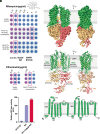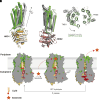Cryo-EM structures of a mycobacterial ABC transporter that mediates rifampicin resistance
- PMID: 39226350
- PMCID: PMC11406275
- DOI: 10.1073/pnas.2403421121
Cryo-EM structures of a mycobacterial ABC transporter that mediates rifampicin resistance
Abstract
Drug-resistant Tuberculosis (TB) is a global public health problem. Resistance to rifampicin, the most effective drug for TB treatment, is a major growing concern. The etiological agent, Mycobacterium tuberculosis (Mtb), has a cluster of ATP-binding cassette (ABC) transporters which are responsible for drug resistance through active export. Here, we describe studies characterizing Mtb Rv1217c-1218c as an ABC transporter that can mediate mycobacterial resistance to rifampicin and have determined the cryo-electron microscopy structures of Rv1217c-1218c. The structures show Rv1217c-1218c has a type V exporter fold. In the absence of ATP, Rv1217c-1218c forms a periplasmic gate by two juxtaposed-membrane helices from each transmembrane domain (TMD), while the nucleotide-binding domains (NBDs) form a partially closed dimer which is held together by four salt-bridges. Adenylyl-imidodiphosphate (AMPPNP) binding induces a structural change where the NBDs become further closed to each other, which downstream translates to a closed conformation for the TMDs. AMPPNP binding results in the collapse of the outer leaflet cavity and the opening of the periplasmic gate, which was proposed to play a role in substrate export. The rifampicin-bound structure shows a hydrophobic and periplasm-facing cavity is involved in rifampicin binding. Phospholipid molecules are observed in all determined structures and form an integral part of the Rv1217c-1218c transporter system. Our results provide a structural basis for a mycobacterial ABC exporter that mediates rifampicin resistance, which can lead to different insights into combating rifampicin resistance.
Keywords: ABC transporter; Mycobacterium tuberculosis; drug resistance; rifampicin.
Conflict of interest statement
Competing interests statement:The authors declare no competing interest.
Figures




References
-
- WHO, “Global tuberculosis report 2023” (World Health Organization, Geneva, 2023).
-
- Telenti A., et al. , Detection of rifampicin-resistance mutations in Mycobacterium tuberculosis. Lancet 341, 647–650 (1993). - PubMed
MeSH terms
Substances
Grants and funding
LinkOut - more resources
Full Text Sources
Medical

